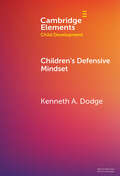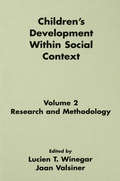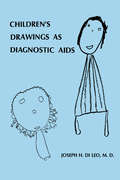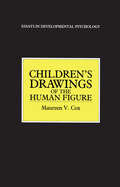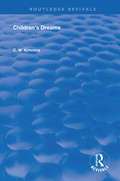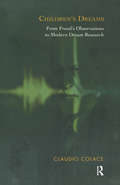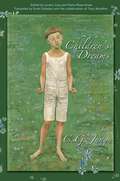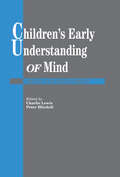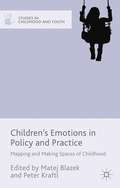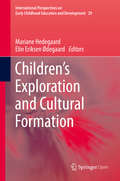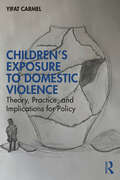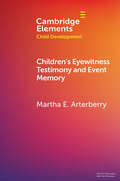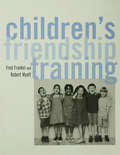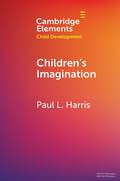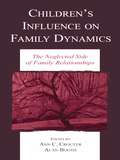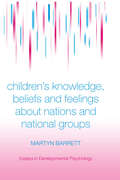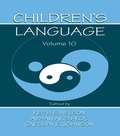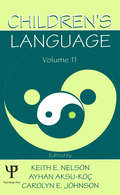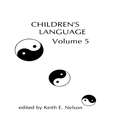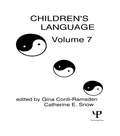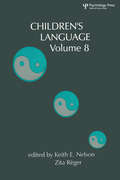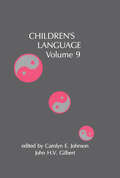- Table View
- List View
Children's Defensive Mindset (Elements in Child Development)
by Kenneth A. DodgeThe primary psychological process leading aggressive children to grow into dysfunctional adults is a defensive mindset, which encompasses a pattern of deviant social information processing steps, including hypervigilance to threat; hostile attributional biases; psychophysiological reactivity, experience of rage and testosterone release (in males); aggressive problem-solving styles; aggressogenic decision-making biases; and deficient behavioral skills. These processes are acquired in childhood and predict adult maladjustment outcomes, including incarceration and premature death. The antecedents of defensive mindset lie in early childhood experiences of trauma and threat. The Fast Track (FT) intervention was designed to improve social competence in aggressive children. A randomized controlled trial demonstrated that FT is effective in preventing externalizing psychopathology; the primary mediating factor is the reduction of defensive mindset processes. This Element concludes with insights that defensive mindset might also explain dysfunction in other realms, including school culture, parenting, marriage, the workplace, intergroup relationships, politics, and international relations.
Children's Development Within Social Context: Volume I: Metatheory and Theory:volume Ii: Research and Methodology
by Jaan Valsiner Lucien T. WinegarThese companion volumes bring together research and theoretical work that addresses the relations between social context and the development of children. They allow for the in-depth discussion of a number of vital metatheoretical, theoretical, and methodological issues that have emerged as a result of increased investigation in these areas. For example: Which methodological and statistical procedures are appropriate and applicable to studies of social context and processes of development? Should the nature of social context be reconceptualized as something more than different levels of some social independent variable? Are theories of development that do not consider social context incomplete? Will the increasingly finer definitions of social context lead to extreme situationism and contextualism? As developmental theory and investigation continues to address relationships between social and cognitive development, it becomes increasingly important that issues concerning social context be elaborated and discussed.
Children's Drawings As Diagnostic Aids
by Joseph H. Di LeoFirst published in 1973. Routledge is an imprint of Taylor & Francis, an informa company.
Children's Drawings of the Human Figure (Essays in Developmental Psychology)
by Maureen V. CoxThe human figure is one of the earliest topics drawn by the young child and remains popular throughout childhood and into adolescence. When it first emerges, however, the human figure in the child's drawing is very bizarre: it appears to have no torso and its arms, if indeed it has any, are attached to its head. Even when the figure begins to look more conventional the child must still contend with a variety of problems: for instance, how to draw the head and body in the right proportions and how to draw the figure in action. In this book, Maureen Cox traces the development of the human form in children's drawings; she reviews the literature in the field, criticises a number of major theories which purport to explain the developing child's drawing skills and also presents new data.
Children's Dreams (Routledge Revivals)
by Charles William KimminsOriginally published in 1920, Children's Dreams offers a rough classification of the type of dream peculiar to children of different ages, showing the variation from year to year and the influence of the environment. Considering children's dreams according to different age brackets ranging from five to eighteen years of age, and also considering the dreams of deaf and blind children, this book understands the important part played by the unconscious in the child's normal behaviour and recognises its educational value.
Children's Dreams: From Freud's Observations to Modern Dream Research
by Claudio ColaceThis book aims to present a study on the actuality and empirical value of Freuds dream theory, even if through the analysis of a specific part of it - the hypotheses about childrens dreams. It provides a systematic description of Freuds observations on child dreaming and presents the results obtained from four empirical studies on childrens dreams that the author conducted during the span of a decade. These studies (two conducted in school settings, one in a home setting, and one based on a questionnaire completed by parents) allow an empirical judgment on Freuds main hypotheses on child dreaming: the hypotheses on formal aspect of childrens dreams, the relationship between dream bizarreness and development of the superego functions, and the issue of wish-fulfilment dreams. The author concludes that it is possible to test empirically Freuds hypothesis on the early forms of dreaming and that this test is not irrelevant for an empirical judgment of certain more general statements of Freuds dream theory (e.g. the dream censorship hypothesis).
Children's Dreams: Notes from the Seminar Given in 1936-1940 (Jung Seminars #2)
by C. G. JungIn the 1930s C. G. Jung embarked upon a bold investigation into childhood dreams as remembered by adults to better understand their significance to the lives of the dreamers. Jung presented his findings in a four-year seminar series at the Swiss Federal Institute of Technology in Zurich. Children's Dreams marks their first publication in English, and fills a critical gap in Jung's collected works. Here we witness Jung the clinician more vividly than ever before--and he is witty, impatient, sometimes authoritarian, always wise and intellectually daring, but also a teacher who, though brilliant, could be vulnerable, uncertain, and humbled by life's great mysteries. These seminars represent the most penetrating account of Jung's insights into children's dreams and the psychology of childhood. At the same time they offer the best example of group supervision by Jung, presenting his most detailed and thorough exposition of Jungian dream analysis and providing a picture of how he taught others to interpret dreams. Presented here in an inspired English translation commissioned by the Philemon Foundation, these seminars reveal Jung as an impassioned educator in dialogue with his students and developing the practice of analytical psychology. An invaluable document of perhaps the most important psychologist of the twentieth century at work, this splendid volume is the fullest representation of Jung's views on the interpretation of children's dreams, and signals a new wave in the publication of Jung's collected works as well as a renaissance in contemporary Jung studies.
Children's Early Understanding of Mind: Origins and Development
by Peter Mitchell Charlie LewisA major feature of human intelligence is that it allows us to contemplate mental life. Such an understanding is vital in enabling us to function effectively in social groups. This book examines the origins of this aspect of human intelligence. The five sections attempt firstly, to place human development within an evolutionary context, focusing on the possibility of innate components of understanding. The second aim of the book is to examine the roles of early perception, pretence and communication as precursor skills in the development of a grasp of mental states. Thirdly, attention is given to the possibility that children know a good deal more about the mind than is apparent from many studies designed to probe their abilities. Taken together, the chapters in this book mark a new focus within a 'theory of mind' movement, examining a group of skills in infancy and early childhood which culminate towards the end of the preschool period in a more mature understanding of one's and others' mental states. Drawing together researchers from diverse theoretical positions, the aim is to work towards a coherent and unified account of this fundamental human abiity. This book will be of central relevance to psychologists and those in related disciplines, particularly education and philosophy.
Children's Emotions in Policy and Practice: Mapping and Making Spaces of Childhood (Studies in Childhood and Youth)
by Peter Kraftl Matej BlazekThis volume examines children's and young people's emotions in policy-making and professional practice. It seeks both to inform readers about up-to-date research and to provoke debate, encouraging and enabling critical reflections upon emotions in policy and practice, relevant to readers' own context.
Children's Exploration and Cultural Formation (International Perspectives on Early Childhood Education and Development #29)
by Mariane Hedegaard Elin Eriksen ØdegaardThis open access book examines the educational conditions that support cultures of exploration in kindergartens. It conceptualises cultures of exploration, whether those cultures are created through children’s own engagement or are demanded of them through undertaking specific tasks within different institutional settings. It shows how the conditions for children’s exploration form a web of activities in different settings with social relationships, local landscapes and artefacts. The book builds on the understanding of cultural traditions as deeply implicated in the developmental processes, meaning that local considerations must be reflected in education for sustainable futures. Therefore the book examines and conceptualises exploration and cultural formation through locally situated cases and navigates toward global educational concepts. The book provides different windows into how children may explore in everyday practice settings in kindergarten, and contributes to a loci-based, ecological, integral knowledge relevant for early childhood education.
Children's Exposure to Domestic Violence: Theory, Practice, and Implications for Policy
by Yifat CarmelThis book bridges together research, theory, and practice to offer future directions for new treatment policy and context-based intervention with children exposed to domestic violence. Centering the voices of children, this book aims to reveal and fill in the gaps of knowledge concerning deep levels of exposure to the domestic violence phenomenon. The book begins with a critical review of the whole field, covering theory, research, intervention, and policy. The author then puts forward a new data-based conceptualization for understanding this field of abuse and its application in practice. Drawing on her rich academic and clinical experience, Carmel includes treatment recommendations, planning, and intervention strategies as well as suggestions for how to deal with the phenomenon at policy level in the legal, social, community, and education fields. Calling for the involvement of legal, educational, and community systems, this book is essential reading for researchers in psychology, law, social work, education, gender studies, and sociology, as well as therapeutic practitioners, such as clinicians, educational consultants, art therapists, and policymakers.
Children's Eyewitness Testimony and Event Memory (Elements in Child Development)
by Martha E. ArterberryThis Element addresses the factors that influence children's accuracy in reporting on events and draws implications for children's ability to serve as reliable eyewitnesses. This Element focusses on short- and long-term memory for event details, memory for stressful events, memory for the temporal order of events, memory for the spatial location of events, the ways poorly worded questions or intervening events interfere with memory, and individual differences in language development, understanding right from wrong and emotions, and cognitive processes. In addition, this Element considers how potential jurors perceive children as eyewitnesses and how the findings of the research on children's event memory inform best practices for interviewing children.
Children's Friendship Training
by Fred D. Frankel Robert J. MyattFirst published in 2003. Routledge is an imprint of Taylor & Francis, an informa company.
Children's Human Rights in the USA: Challenges and Opportunities (Clinical Sociology: Research and Practice)
by Yvonne VissingThis book critically examines why a human rights framework would improve the wellbeing and status of young people. It explores children’s rights to provision, protection, and participation from human rights and clinical sociological perspectives, and from historical to contemporary events. It discusses how different ideologies have shaped the way we view children and their place in society, and how, despite the rhetoric of children's protection, people under 18 years of age experience more poverty, violence, and oppression than other group in society. The book points to the fact that the USA is the only member of the United Nations not to ratify a children’s human rights treaty; and the impact of this decision finds US children less healthy and less safe than children in other developed countries. It shows how a rights-respecting framework could be created to improve the lives of our youngest citizens – and the future of democracy. Authored by a renowned clinical sociologist and international human rights scholar, this book is of interest to researchers, students, social workers and policymakers working in the area of children's wellbeing and human rights.
Children's Imagination (Elements in Child Development)
by Paul L. HarrisChildren's imagination was traditionally seen as a wayward, desire-driven faculty that is eventually constrained by rationality. A more recent, Romantic view claims that young children's fertile imagination is increasingly dulled by schooling. Contrary to both perspectives, this Element argues that, paradoxically, children's imagination draws much inspiration from reality. Hence, when they engage in pretend play, envision the future, or conjure up counterfactual possibilities, children rarely generate fantastical possibilities. Their reality-guided imagination enables children to plan ahead and to engage in informative thought experiments. Nevertheless, when adults present children with less reality-based possibilities – via biblical narratives or the endorsement of special beings – children are receptive. Indeed, such imaginary possibilities can infuse their otherwise commonsensical appraisal of reality. Finally, like adults, young children enjoy being absorbed into a make-believe, fictional world but faced with real-world problems calling for creativity, they often need guidance, given their limited knowledge of prior solutions.
Children's Influence on Family Dynamics: The Neglected Side of Family Relationships (Penn State University Family Issues Symposia Series)
by Alan Booth Ann C. CrouterAny parent who has raised more than one child is likely to be keenly aware of subtle or even striking differences among their offspring. The central premise of this volume is that children bring personal qualities to their relationships with other family members that help shape family interaction, relationships, and even processes that family researchers have called "parenting." The chapters address how children's personal qualities make their mark on families in ways that may in turn influence children's subsequent development. The volume is based on the presentations and discussions from a national symposium on "Children's influence on family dynamics: The neglected side of family relationships" held at the Pennsylvania State University, as the ninth in a series of annual interdisciplinary symposia focused on family issues. It is divided into four parts, each dealing with a different aspect of the topic. Part I sets the stage by focusing on the features of children that make a difference, as well as the kinds of research designs that are likely to shed light on the role of child influences. Part II focuses on early childhood, particularly the role of infant temperament and other individual differences in very young children in shaping their parents' behaviors, reactions in turn that feedback and influence the developing child. Part III focuses on adolescence, a time when young people are able to exert more choice in how they spend their time and who they spend it with. Part IV pulls the themes of the volume together and points the way for future research.
Children's Knowledge, Beliefs and Feelings about Nations and National Groups (Essays in Developmental Psychology)
by Martyn BarrettThis book provides a state-of-the-art account of how people's subjective sense of national identity, and attitudes towards countries and national groups, develop through the course of childhood and adolescence. It offers a comprehensive review of the research which has been conducted into: . children's understanding of nations as geographical territories and as political, historical and cultural communities . children's knowledge, beliefs and feelings about the people who belong to different national groups . children's attitudes towards, and emotional attachment to, their own country and national group. The authors elaborate on the developmental patterns that have been found to emerge, contextualized by a consideration and evaluation of the theoretical frameworks which can be used to explain these patterns. Written by the leading international authority in this field, and reporting (in collaboration with his colleagues) the findings from two major transnational research projects, this book will be invaluable to postgraduate students and researchers working in this field. The book will also be of great benefit to undergraduate students taking courses in Developmental Psychology, the Sociology of Childhood, and Education.
Children's Language: Volume 10: Developing Narrative and Discourse Competence (Children's Language Ser.)
by Ayhan Aksu-Koç Keith E. Nelson Carolyn E. JohnsonThese volumes present coherent sets of papers developed along two of the thematic lines that underscored the program of the meeting of the International Association for the Study of Child Language in Istanbul in the summer of 1996. Thoroughly reviewed and updated to reflect the state of child language research and theory--particularly in the domains of discourse and interaction--they convey not only the flavor of that meeting but some of the most exciting trends in the field today. Each contribution in Volume 10, Developing Narrative and Discourse Competence, focuses on the differential effects of discourse genres, elicitation techniques, communicative contexts, literacy and schooling, and the oft-cited variables of age, language, and culture. Issues concerning the interrelations between social, cognitive, and affective capacities and processes in discourse are addressed. Each chapter raises theoretical questions regarding how and when representations are constructed to support new complexities. Presenting data from a cross-cultural and cross-linguistic perspective, this volume highlights both the particulars and the universals of the processes involved. The chapters in Volume 11, Interactional Contributions to Language Development, address issues including scaffolding of processing and learning in particular interactional sequences; linkages among interpersonal functions or relations, cognitive development, and semantic, syntactic, and pragmatic devices or forms; and models of how interactions proceed, input is selected, and learning advances across multiple rounds of interaction. Each of these volumes will be a valuable addition to the libraries of all who study the development of language.
Children's Language: Volume 11: Interactional Contributions To Language Development (Children's Language Ser.)
by Ayhan Aksu-Koç Keith E. Nelson Carolyn E. JohnsonThese volumes present coherent sets of papers developed along two of the thematic lines that underscored the program of the meeting of the International Association for the Study of Child Language in Istanbul in the summer of 1996. Thoroughly reviewed and updated to reflect the state of child language research and theory--particularly in the domains of discourse and interaction--they convey not only the flavor of that meeting but some of the most exciting trends in the field today. Each contribution in Volume 10,Developing Narrative and Discourse Competence, focuses on the differential effects of discourse genres, elicitation techniques, communicative contexts, literacy and schooling, and the oft-cited variables of age, language, and culture. Issues concerning the interrelations between social, cognitive, and affective capacities and processes in discourse are addressed. Each chapter raises theoretical questions regarding how and when representations are constructed to support new complexities. Presenting data from a cross-cultural and cross-linguistic perspective, this volume highlights both the particulars and the universals of the processes involved. The chapters in Volume 11, Interactional Contributions to Language Development, address issues including scaffolding of processing and learning in particular interactional sequences; linkages among interpersonal functions or relations, cognitive development, and semantic, syntactic, and pragmatic devices or forms; and models of how interactions proceed, input is selected, and learning advances across multiple rounds of interaction. Each of these volumes will be a valuable addition to the libraries of all who study the development of language.
Children's Language: Volume 4 (Children's Language Series)
by Keith E. NelsonFirst published in 1983. This series, Children’s Language, reflects the conviction that extensive work on entirely new fronts along with a great deal of reinterpretation of old-front data will be necessary before any persuasive and truly orderly account of language. For all volumes in the series there is a common scheme of operation with two tactics. First, to give authors sufficient planning time and freedom to arrive at a chapter-length account of their area of thinking which vividly shows both the progress and the problems in that area, with the author of each chapter free to find a workable proportion of new experimental contributions, review, and theory. The second tactic concerns the selection of topics for each volume. This is Volume 4. Structures about language and thought and children as employed in certain other fields may well be shaken and stimulated, particularly in education, sociology, anthropology, literature, and language remediation.
Children's Language: Volume 5 (Children's Language Series)
by Keith E. NelsonFirst published in 1985. In children’s language we are in search of the “ great bears,” the clear solid patterns that hold up after countless angles of view and after many, many lenses have been tried. In the first four volumes of this series, Children's Language, there has been coverage of alternative theories and methods in syntax, semantics, discourse, phonology, figurative language, second language learning, the transition to text processing, and story structures, among other topics. In order to present a lively account of development, the authors in the first four volumes were encouraged to each adopt a flexible format—one that best fit their own material rather than sticking to a standard review organization. Exactly the same approach has been taken by the authors of the present volume 5.
Children's Language: Volume 6 (Children's Language Series)
by Keith E. Nelson; Anne van KleeckThis series, Children’s Language, reflects the conviction that extensive work on entirely new fronts along with a great deal of reinterpretation of old-front data will be necessary before any persuasive and truly orderly account of language development can be assembled. None of the chapters are simply reviews, and none of the volumes are " handbooks" or " reviews" or introductory texts. Rather the volumes try to capture the excitement and complexity of thinking and research at the growing, advancing edges of this broad field of children’s language. In line with these goals for the Children’s Language series the present volume includes coverage of a fairly wide range of topics and subtopics. The authors for each chapter will weave their own story and we leave to them the introduction of their main plots and the major and minor characters in their scientific stories. This is volume 6.
Children's Language: Volume 7 (Children's Language Series)
by Catherine E. Snow Gina Conti-RamsdenThis volume presents current research findings on vital issues in language development compiled by an international group of leading researchers. The data are drawn from studies of the acquisition of Swedish, Polish, Serbo-Croatian, Hungarian, Portuguese, Italian, and English. Themes emphasized in all the chapters include the importance of the social context of acquisition, the existence of interconnections among various domains of language development, and the impossibility of understanding acquisition using a simple theory or a single methodological approach.
Children's Language: Volume 8 (Children's Language Series)
by Keith E. Nelson Zita RégerEach child is spoken to by genetic heritage and by the rich current set of interactional environments -- familial, local community, and broader cultural voices. Using past structures and paradigms of scholarship, scholars seek to understand what the child achieves in language and how. The tools available for this research are not static but evolve jointly through the sharing of information, and with each "brief moment in time" in efforts to look at children's languages "just as they are." Containing a wide range of contributions from developmental approaches to phonological ability, the lexicon, the grammar as well as conversation and sign language, this text details the interrelated research and theorizing discussed at a recent Budapest conference. The meeting of the International Association for the Study of Child Languages was particularly rich in the diversity of scholars present, which is highly appropriate because such diversity is integral to an informed study of children's language.
Children's Language: Volume 9 (Children's Language Series)
by Carolyn E. Johnson John H. V. GilbertThis volume brings together the work of 32 scholars from 13 countries -- investigations of children learning 15 different languages, in some instances more than one at a time. The scope of this work -- as broad as it is -- only partially represents the research interests and approaches of the more than 350 scholars from 34 countries who contributed papers or posters to the Sixth International Congress for the Study of Child Language. This investigative power and diversity are, for the most part, focused on topics and issues of modern day child language research that have been under discussion for the last 30 years or so. Some even go beyond that in early diary studies and philosophers' speculations. While the issues are mainly familiar ones, the 17 chapters contribute to the advancement of child language study in several specific ways. They: * represent current theoretical frameworks, both bringing the insights of the theories to the interpretation of language development and testing tenets or implications of the theories with child language data; * contribute substantively to the crosslinguistic study of child language, reflecting both the linguistic diversity of the authors themselves and a recent major shift in the approach to child language study; * build on the now considerable body of knowledge about children's language, both adding to information about the basic systems of phonology, syntax, and semantics, and extending beyond to explore aspects of narrative and literacy development, language acquisition by bilingual and atypical children, and language processing; and * contain hints of new directions in child language study, such as increased attention to the impact of phonology on other language systems. Taken as a whole, this volume reflects the current strength of crosslinguistic research, the application and testing of new theoretical developments, a new legitimacy of language disorder data, and a new appeal to the descriptive possibilities of language processing models. In addition, there is a theme that runs through many of the chapters and points the way for important research in the future: the role of prosody in the acquisition of various language structures and systems.
